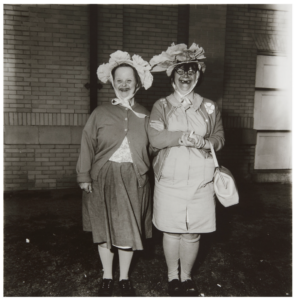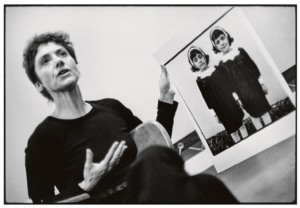The Louisiana Museum, Denmark – March 24, 2022 to…. Forget it.
I managed to get to Louisiana, an art institution in Denmark, which has for many years been at the forefront of staging excellent exhibitions of mostly 20th century art. The museum has a strong enough collection to lend and borrow and thereby attract the best.
I admit my expectations were high. Diane Arbus was why I got into photography in the first place. The very unstable looking kid in Central Park holding a hand grenade was my trigger to change direction from Renaissance Art to Photography. Reading that the first ‘major’ exhibition of Arbus’ work in Scandinavia was only half an hour up the road from where I was staying, was an opportunity too good to miss.
This past Sunday, I made the short journey and couldn’t wait to see something about this great photographer that was new. Maybe even a few images I had not seen before. Maybe a visit with some of my favourite works. Alas, I was deeply disappointed.
The selection of work was limited – exclusively drawn from the Art Gallery of Ontario collection in Toronto – and the whole thing felt like a travelling road-show. It felt canned and hung because it was easy and fast. The AGO collection is far from exhaustive and has large gaps. The Louisiana Museum had many months to plan and prepare this show, given COVID and with our new knowledge of how to use tools like Zoom, or Teams, I see no reason why they did not take the opportunity and bring together something much more exciting.
My main challenge, was placing the works in chronological order, which doesn’t really work with the Untitleds, which form such a major part of her body of work. The subjects, which Arbus photographed in her many Untitled images, often have Down’s Syndrome, while others again are simply institutionalized ‘inmates’ with no voice of their own. These photographs are problematic in today’s context. Hanging them does not take into account critical issues around exploitation and the gaining of permission. Yes, the State may have allowed Arbus access, but that does not give her the right to shoot without permission, or does it?

One of the early labels attached to an image I do not recall, quotes Arbus saying something like, and I am paraphrasing: “….. my style of photography and a short lens demand that I ask my subjects permission before photographing them.” I do believe the Museum should have spoken to this when it comes to subjects that never had the choice, nor the voice. I presume by mixing in the Untitleds with the other works, the curator somehow thought he didn’t have to comment?
The labels accompanying each photograph start out being plentiful in content, but virtually become title, medium, date towards the time when Arbus’ style was more fully developed (larger square format prints). There is no mention of the famous set of images of which she sold only a single set to none other than Richard Avedon (unless I missed it), nor was it clear which grants she did, or didn’t get. There was a blown up low quality poster print of one of her applications glued to the wall – I think to the Guggenheim Foundation – which if successful should give hope to every aspiring photographer. It was rambling and poorly written, and certainly not terribly helpful for a jury to evaluate. The label did not say if she was successful in that particular instance.
Had the Louisiana curator and his team bothered to let it be known that this show was being assembled, there are experts abound who know Arbus and her work inside-out and backwards. Where for instance were the reference works? Where was Lisette Model’s Woman with a Veil, San Francisco, 1949, which so deeply inspired Arbus’ work. Where are the contemporaries. The Winogrands, etc. The Museum even had the recently published book from the seminal 1967 show in its bookshop, but it doesn’t show any examples. (New Documents – Arbus, Friedlander, Winogrand, MoMA 1967, curated by John Szarkowski).
Finally, Identical Twins hung on its own. A perpendicular short wall set up just for this image. Unfortunately, I am a little over this image. Over exposure perhaps, but it remains the cornerstone of any serious Arbus show, as it should. Identical Twins was – I think – printed by Arbus herself (I assume it was, as no Selkirk reference was given). It hung there in all its glory, but with a mat so tight to the image that you cannot see the border or framing at all. Anyone with any knowledge of Arbus and her work will know that she spent many, many darkroom hours working on how to use the edge of the negatives to create a frame around her work. The edge of the negative being part of how Arbus worked.
I have read many accounts of how Neil Selkirk – who printed for the the Arbus Estate under the direction of Arbus’ daughter – spent hours trying to copy the technique Arbus used to give the proper feel to each print. I do not understand why Identical Twins was framed the way it was. It makes no sense, as every other square format photograph in the larger size was hung in a frame with a mat that clearly showed the entire negative frame.
In the image below, which I grabbed off the internet, it is very clear what the border of an Arbus printed image of Identical Twins should look like.

The Danish population overall is not well educated in photography, the history of, or even the names of some of the key masters of the art. This is a great shame, given the role of photography in art today. You need only go look at the ‘photography’ section at the only important auction house in the country, Bruun-Rasmussen, to see that there is no market, nor it seems any interest in Denmark. Nobody is laying the foundation of knowledge, which is so disappointing. Louisiana’s has had a key role in bringing 20th century art to life and to the Danes. It had an opportunity with Diane Arbus to start doing so for photography, but chose instead to bring in a canned show with little or no context.
I looked into the curator, whom I understand is well respected. From my little and limited research online, he has the art history credentials, but with no, or very limited photography background. He is incidentally also the head of acquisitions at the Louisiana Museum, which again does not bode well for photography. Incidentally, I happen to know a couple of the photography curators that used to work at the Art Gallery of Ontario. They eat, breathe, sleep and dream of photographs. At Louisiana…. not so much.
The Diane Arbus show was such a wasted opportunity for the Louisiana Museum, and for their second act, well, the second act is just shameful. This summer, the Louisiana Museum will have a show of Richard Prince’s work. I wrote about this appropriating, unscrupulous, so-called ‘artist’ in a recent post. Needless to say, I will not be going.
Harbel


